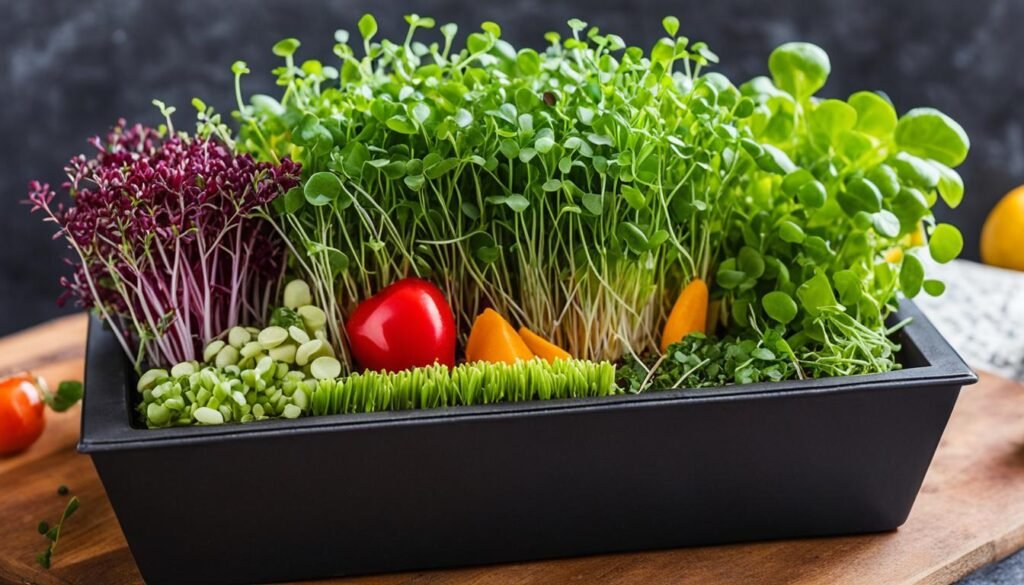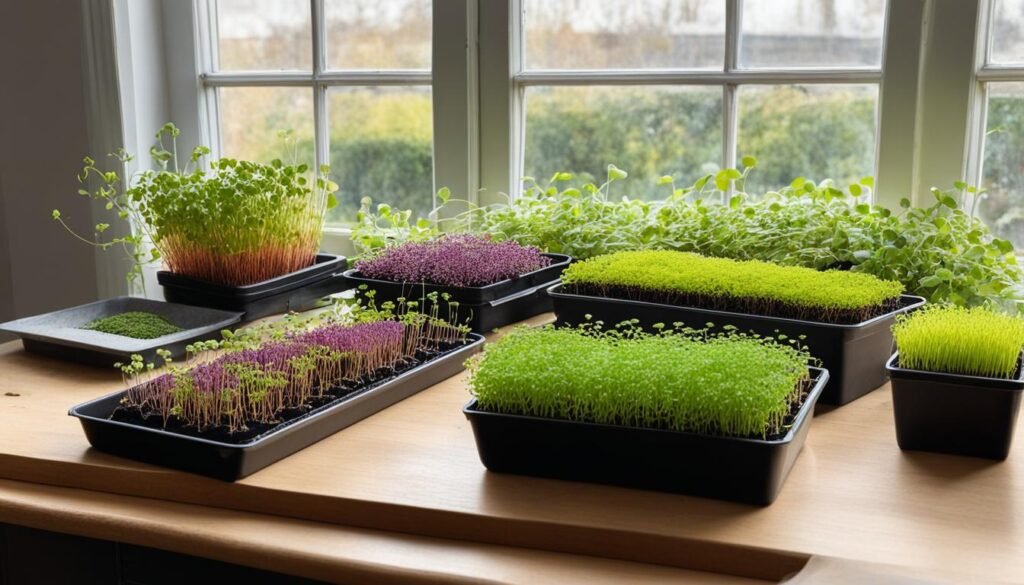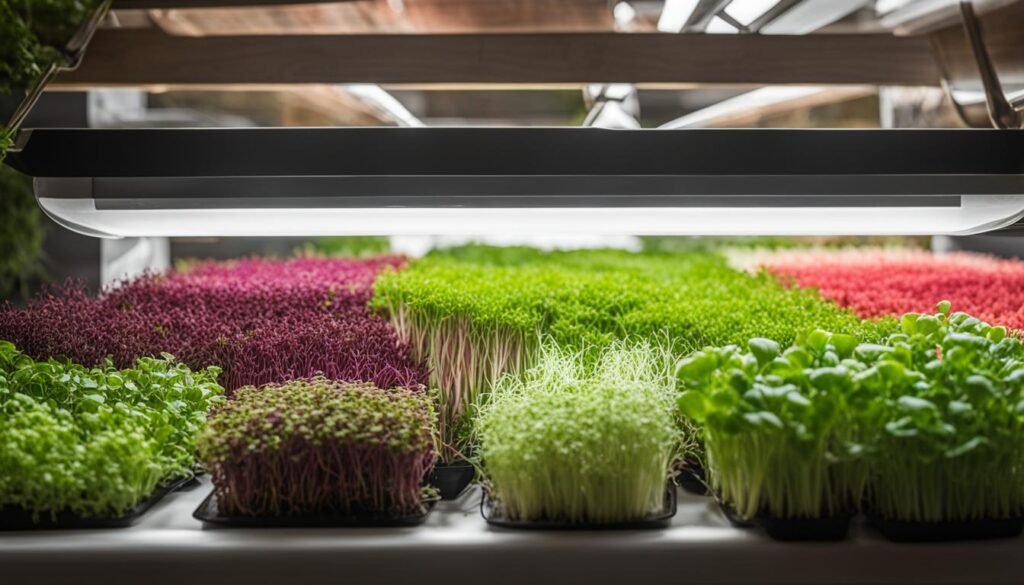Microgreens are simple, small, and nutritious plants that can be easily grown at home, even indoors. They offer many rewarding aspects for gardeners, providing fresh and delicious greens right at your fingertips. Unlike traditional gardening, microgreens can be started with a simple setup of seeds, soil, water, artificial light, and trays. They are quick-growing and can be harvested in just a few days, making them a convenient option for those who want to grow their own food. Whether you are a beginner or an experienced gardener, growing microgreens can provide a range of benefits, including fresh produce, cost savings, and the satisfaction of growing your own food. Is growing microgreensworth it?
Key Takeaways:
- Growing microgreens at home is a rewarding and convenient way to have fresh produce.
- Microgreens are quick-growing and can be harvested in just a few days.
- They are a cost-effective option, saving you money on grocery bills.
- Growing microgreens provides the satisfaction of growing your own food.
- Microgreens offer a range of nutrients and health benefits.
The Health Benefits of Growing Microgreens
Microgreens are not just tasty, they are also packed with nutrients. These young vegetable greens contain high levels of potassium, iron, zinc, magnesium, and copper, making them a great addition to a healthy diet. In fact, studies have shown that microgreens have higher vitamin, mineral, and antioxidant levels compared to mature greens. They are a concentrated source of beneficial plant compounds, such as antioxidants, which can help reduce the risk of certain diseases, including heart disease, Alzheimer’s disease, diabetes, and certain cancers.
Growing microgreens indoors allows you to have a fresh supply of nutritious greens throughout the year, while also saving money on grocery bills. Additionally, microgreens can be a profitable venture for those interested in starting a microgreen business, as there is a growing demand for these nutritious greens.

Indoor microgreen gardening is a convenient and efficient way to cultivate these nutrient-rich greens. By growing microgreens at home, you have control over the growing conditions, ensuring they are free from pesticides and other harmful chemicals. This not only enhances their nutritional value but also provides you with peace of mind knowing that you are consuming pure and wholesome greens.
Whether you are a health-conscious individual looking to boost your nutrient intake or a budding entrepreneur exploring new avenues for profit, growing microgreens is a smart choice. With their numerous health benefits and increasing popularity, microgreens offer a win-win situation for your well-being and your pocket.
How to Grow Microgreens at Home
Growing microgreens at home is a simple and rewarding process. With a few basic supplies and some patience, you can enjoy a fresh supply of nutritious greens right from your kitchen. Here’s a step-by-step guide on how to grow microgreens:
- Choose good-quality seeds: Start by selecting high-quality seeds specifically meant for microgreen cultivation. Some popular microgreens for beginners include broccoli, radish, and sunflower.
- Prepare a suitable growing medium: You can use either soil or a growing mat as a medium for your microgreens. Make sure it’s clean and free from any contaminants.
- Provide proper lighting: Microgreens need at least 12-16 hours of light per day. If you don’t have access to direct sunlight, you can use artificial light sources, such as fluorescent or LED grow lights.
- Plant the seeds: Fill a container with soil or place a growing mat in it. Sprinkle the seeds evenly on top, ensuring they are not too crowded. Gently press them into the soil or mat using your fingers.
- Mist with water: Use a spray bottle to mist the seeds with water. This helps to moisten the soil without disturbing the seeds.
- Cover and germinate: Cover the container with a plastic lid or plastic wrap to create a greenhouse-like environment. This helps to retain moisture and promotes germination.
- Remove the cover: Once the seeds germinate, remove the plastic cover to allow air circulation. Place the container in a well-ventilated area.
- Provide daily watering: Water the microgreens lightly once a day to keep the soil or mat moist. Avoid overwatering, as excessive moisture can lead to mold or rot.
- Harvest your microgreens: After 7-10 days, your microgreens will be ready to harvest. Use clean scissors or a sharp knife to cut the greens just above the soil level.
- Enjoy your homegrown microgreens: Rinse the harvested microgreens gently under cool water to remove any soil particles. They are now ready to be added to salads, soups, sandwiches, or used as a garnish for various dishes.

Indoor Microgreen Gardening
One of the great advantages of growing microgreens at home is that you can have a fresh supply of nutritious greens year-round. By utilizing indoor spaces and proper lighting, you can create an ideal environment for your microgreens to thrive. Indoor microgreen gardening allows you to control factors like temperature, humidity, and lighting, ensuring optimal growth and a bountiful harvest.
The Pros and Cons of Growing Microgreens
While there are many benefits to growing microgreens, it is important to consider the potential downsides as well. Let’s take a closer look at the pros and cons of microgreen farming and cultivation.
The Pros of Growing Microgreens
Microgreens offer several advantages that make them an attractive option for sustainable farming and starting a microgreen business:
- Quick turnaround: Microgreens have a short growth cycle and can be harvested in just a few days, allowing for a fast and continuous supply of fresh greens.
- Minimal space and resources: Microgreens can be grown in small areas, including indoors, making them ideal for urban environments and limited space. They require less water and soil compared to traditional farming methods.
- Year-round cultivation: With indoor microgreen gardening, you can grow microgreens throughout the year, unaffected by seasonal changes. This ensures a constant supply of nutritious greens, no matter the weather.
- Controlled growing conditions: Indoor cultivation allows you to have full control over the growing environment, including temperature, light, and nutrients, resulting in consistent and high-quality microgreens.
- High market value: Microgreens are in high demand due to their nutritional benefits and versatility in culinary dishes. This presents a profitable opportunity for individuals interested in starting a microgreen business.
The Cons of Growing Microgreens
Despite their many advantages, growing microgreens also comes with some challenges to be aware of:
- Labor-intensive: Cultivating microgreens requires regular attention and care, including watering, monitoring, and harvesting. It can be a time-consuming process, especially when scaling up production.
- Ongoing maintenance: Microgreens need consistent maintenance, such as pest control, ensuring proper lighting, and monitoring for any issues that may arise during the growth cycle.
- Market demand and competition: Finding the right market and ensuring a steady demand for your microgreens can be a challenge. It’s important to research and identify potential customers, such as local restaurants, farmers markets, or health-conscious individuals.
While there are considerations and challenges associated with growing microgreens, the benefits and potential profitability make it an attractive endeavor for sustainable farming and microgreen businesses.

What Are the Health Benefits of Growing and Consuming Microgreens?
Radish microgreens health benefits include high levels of antioxidants, vitamins, and minerals. Consuming these young plants can aid in improving digestion, boosting the immune system, and reducing the risk of chronic diseases. Growing microgreens at home is an easy and cost-effective way to incorporate these healthful greens into your diet.
Conclusion, Is Growing Microgreens Worth It
Growing microgreens can be a highly rewarding and profitable venture for individuals interested in cultivating their own nutritious greens. By understanding the benefits and health advantages, as well as mastering the proper techniques for microgreen farming, you can enjoy the convenience of having fresh produce at your fingertips while potentially generating income.
While there are considerations and challenges associated with microgreen cultivation, the numerous benefits outweigh the drawbacks. Whether you’re a beginner looking to start a small indoor garden or an experienced gardener seeking to expand into microgreen farming, the world of microgreens offers a wealth of possibilities for personal and financial growth.
So, if you’re wondering if growing microgreens is worth it, the answer is a resounding yes. Embrace the perks of these tiny greens and embark on your microgreen farming journey today. Let the microgreen business bloom and discover the immense rewards that await!

